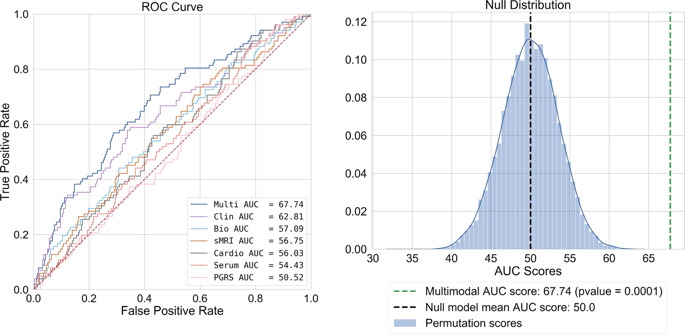当前位置:
X-MOL 学术
›
Transl. Psychiaty
›
论文详情
Our official English website, www.x-mol.net, welcomes your feedback! (Note: you will need to create a separate account there.)
Predicting rehospitalization within 2 years of initial patient admission for a major depressive episode: a multimodal machine learning approach.
Translational Psychiatry ( IF 6.8 ) Pub Date : 2019-11-11 , DOI: 10.1038/s41398-019-0615-2 Micah Cearns 1 , Nils Opel 2, 3 , Scott Clark 1 , Claas Kaehler 2 , Anbupalam Thalamuthu 4 , Walter Heindel 5 , Theresa Winter 6, 7 , Henning Teismann 8 , Heike Minnerup 8 , Udo Dannlowski 2 , Klaus Berger 8 , Bernhard T Baune 2, 9, 10
Translational Psychiatry ( IF 6.8 ) Pub Date : 2019-11-11 , DOI: 10.1038/s41398-019-0615-2 Micah Cearns 1 , Nils Opel 2, 3 , Scott Clark 1 , Claas Kaehler 2 , Anbupalam Thalamuthu 4 , Walter Heindel 5 , Theresa Winter 6, 7 , Henning Teismann 8 , Heike Minnerup 8 , Udo Dannlowski 2 , Klaus Berger 8 , Bernhard T Baune 2, 9, 10
Affiliation

|
Machine learning methods show promise to translate univariate biomarker findings into clinically useful multivariate decision support systems. At current, works in major depressive disorder have predominantly focused on neuroimaging and clinical predictor modalities, with genetic, blood-biomarker, and cardiovascular modalities lacking. In addition, the prediction of rehospitalization after an initial inpatient major depressive episode is yet to be explored, despite its clinical importance. To address this gap in the literature, we have used baseline clinical, structural imaging, blood-biomarker, genetic (polygenic risk scores), bioelectrical impedance and electrocardiography predictors to predict rehospitalization within 2 years of an initial inpatient episode of major depression. Three hundred and eighty patients from the ongoing 12-year Bidirect study were included in the analysis (rehospitalized: yes = 102, no = 278). Inclusion criteria was age ≥35 and <66 years, a current or recent hospitalisation for a major depressive episode and complete structural imaging and genetic data. Optimal performance was achieved with a multimodal panel containing structural imaging, blood-biomarker, clinical, medication type, and sleep quality predictors, attaining a test AUC of 67.74 (p = 9.99-05). This multimodal solution outperformed models based on clinical variables alone, combined biomarkers, and individual data modality prognostication for rehospitalization prediction. This finding points to the potential of predictive models that combine multimodal clinical and biomarker data in the development of clinical decision support systems.
中文翻译:

预测首次抑郁患者入院后2年内的重度抑郁症发作:多模式机器学习方法。
机器学习方法显示出将单变量生物标志物发现转化为临床上有用的多元决策支持系统的希望。目前,在重度抑郁症中的工作主要集中在神经影像和临床预测手段上,而遗传,血液生物标志物和心血管手段却缺乏。此外,尽管有临床重要性,但对于最初住院的重度抑郁发作后再住院的预测尚待探索。为了弥补文献中的这一空白,我们使用基线临床,结构成像,血液生物标志物,遗传(多基因风险评分),生物电阻抗和心电图预测因子来预测住院期间主要抑郁症发作后2年内的住院治疗。正在进行的为期12年的双向研究的380名患者被纳入分析(重新住院:是= 102,否= 278)。纳入标准为年龄≥35岁且<66岁,当前或近期因严重抑郁发作而住院,并具有完整的结构成像和遗传数据。包含结构成像,血液生物标志物,临床,药物类型和睡眠质量预测因子的多模式面板可实现最佳性能,测试AUC达到67.74(p = 9.99-05)。这种多模式解决方案优于仅基于临床变量,组合生物标志物和用于住院治疗预测的单独数据模式预测的模型。
更新日期:2019-11-11
中文翻译:

预测首次抑郁患者入院后2年内的重度抑郁症发作:多模式机器学习方法。
机器学习方法显示出将单变量生物标志物发现转化为临床上有用的多元决策支持系统的希望。目前,在重度抑郁症中的工作主要集中在神经影像和临床预测手段上,而遗传,血液生物标志物和心血管手段却缺乏。此外,尽管有临床重要性,但对于最初住院的重度抑郁发作后再住院的预测尚待探索。为了弥补文献中的这一空白,我们使用基线临床,结构成像,血液生物标志物,遗传(多基因风险评分),生物电阻抗和心电图预测因子来预测住院期间主要抑郁症发作后2年内的住院治疗。正在进行的为期12年的双向研究的380名患者被纳入分析(重新住院:是= 102,否= 278)。纳入标准为年龄≥35岁且<66岁,当前或近期因严重抑郁发作而住院,并具有完整的结构成像和遗传数据。包含结构成像,血液生物标志物,临床,药物类型和睡眠质量预测因子的多模式面板可实现最佳性能,测试AUC达到67.74(p = 9.99-05)。这种多模式解决方案优于仅基于临床变量,组合生物标志物和用于住院治疗预测的单独数据模式预测的模型。


























 京公网安备 11010802027423号
京公网安备 11010802027423号